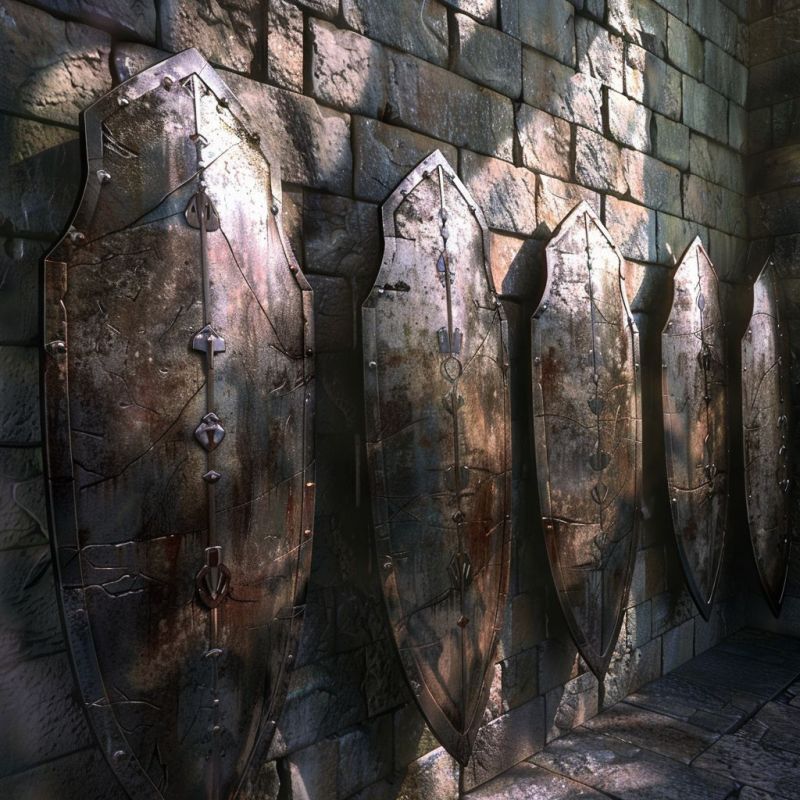


 Inventory Equipped:
Inventory Equipped:-
Medium Shield10 gp
-
Plate900 gp
-
Shortsword10 gp
 Passive Abilities:
Passive Abilities:-
Knightly Presence1500 gp


 Attack Abilities:
Attack Abilities:-
Short Draw400 gp


-
Flourish150 gp


 Reaction Abilities:
Reaction Abilities:-
Interposing Block


-
Unshakable Defense3000 gp


 Opportunity Attack Abilities:
Opportunity Attack Abilities:-
Close Quarters Combat300 gp


The rusted gauntlets tighten, joints screeching as the massive blade rises. In a single, brutal motion, the Living Armor brings it down, metal crashing through the air, its dented helm locked onto you in silent intent.
Appearance & Movement
At first glance, the Living Armor appears to be an ordinary suit of medieval plate, standing motionless in a long-forgotten corridor, propped up in an abandoned armory, or resting amid the ruins of a battlefield. The metal is often tarnished and dented, showing the scars of battles long past, yet when it moves, the motion is eerily smooth—almost too precise for something supposedly hollow. The sound of shifting metal echoes with each step, but no voice calls from within, no breath fogs the air behind the visor.
The Mollusk Colony
Despite its haunting appearance, the true nature of the Living Armor lies within. The suit is not animated by magic or cursed spirits, but by a colony of small mollusk-like creatures that have taken up residence inside. Each individual is no larger than a fist, their slimy bodies covered in chitinous plates, gripping the armor’s inner walls with tendrils and hooked limbs.
One suit of armor typically houses between five to ten of these creatures, each coordinating their efforts to move different parts of the body—some controlling the limbs, others gripping the breastplate and helm, working in near-perfect unison to create the illusion of a single, sentient being. They are not particularly intelligent on their own, but together, they form a hive-like mind capable of complex movement and rudimentary strategy.
Hordes in Hollow Halls
While a single Living Armor is a formidable oddity, they are rarely alone. The mollusks breed rapidly, forming colonies that can infest entire ruins. A single castle abandoned for a few decades may become home to hundreds, even thousands, of these creatures, each set inhabiting different suits of armor—knights, guards, even old ceremonial plate once meant for display.
When disturbed, they react like a hive defending its nest, mobilizing in unsettling numbers. An entire hall lined with rusted armor may suddenly lurch to life, weapons in hand, advancing as a silent phalanx upon the intruders who dared to disturb their domain.
Defensive Instincts & Combat
Despite their appearance as skilled warriors, Living Armors do not fight as a trained soldier would. They lack the true precision of a swordsman and rely instead on brute force and sheer numbers. Their strikes are heavy and relentless, unburdened by fatigue, and when one armor is destroyed, the surviving mollusks quickly retreat, attempting to merge with another nearby suit.
However, their true strength lies in their natural resilience. The armor itself acts as a shield, protecting the soft creatures within. Swords and arrows may clang against the metal plates with little effect, and only well-placed, crushing blows can shatter their shell and expose the mollusks hiding within.
Weakness & Predators
For all their eerie coordination, the creatures are still simple-minded. Fire and intense heat can send them into a frenzy, causing them to abandon their armor and scatter. Likewise, strong electrical currents or heavy concussive force can disrupt their grip, forcing them to release their hold.
In some underground ecosystems, Living Armors have a natural predator—certain burrowing creatures, such as rust beetles or subterranean wyrms, feed upon the mollusks, breaking open the armor to extract their soft, defenseless prey. Adventurers who learn to exploit this relationship may find ways to use the natural order against them.
Uses & Taming
While Living Armors are mostly seen as hazards to explorers, some daring individuals have sought to tame them. Skilled alchemists and beastmasters have attempted to bond with the mollusks, using specially treated armor to attract and control them. In rare cases, a colony can be trained to obey simple commands, creating a self-moving suit of armor that follows its owner like a loyal guardian. However, keeping them in check is a challenge, as their instincts to swarm and spread can quickly spiral out of control.
Some scholars theorize that the creatures once formed a symbiotic relationship with ancient warriors, serving as natural armor enhancers in exchange for protection and sustenance. Whether this is true or simply a myth, the Living Armors remain one of the strangest and most unsettling denizens of abandoned fortresses and ruined strongholds.
Environment:
![]()
Parasite
A parasite is a cunning and insidious organism that thrives by merging with a host, altering its body to ensure its own survival. Whether fungal, carnivorous, or insectoid in nature, all parasites share one grim truth—eventually, their host will perish, leaving the parasite to seek out a new body to infest.
Types of Parasites
Fungal Parasites
Fungal parasites spread through spores, infecting a host’s bloodstream or nervous system. As the infection progresses, the host’s body becomes overgrown with mycelium, enhancing physical strength and endurance while slowly hollowing out the mind. Some fungal parasites form grotesque fruiting bodies on their host, releasing spores upon death to seek out fresh victims.
Carnivorous Parasites
These entities latch onto a host and modify their physiology, often fusing with muscle and bone to create a more efficient predator. Some form external appendages—claws, tendrils, or even additional jaws—while others mutate internal organs, reinforcing bones and thickening flesh. The host’s lifespan is prolonged as long as it remains useful, but once it weakens, the parasite abandons the husk and moves on.
Insectoid Parasites
Insectoid parasites typically enter through wounds, the mouth, or even burrowing into flesh, spreading through their host’s body like a living hive. Some implant eggs that hatch within the host, slowly devouring them from the inside. Others take direct control, wrapping nerves in chitinous tendrils to puppet the host while feeding off its life force.
Effects on the Host
- Physical Augmentations: Parasites may grant their host unnatural strength, speed, or resilience. These enhancements are often grotesque, featuring chitinous plating, fungal armor, or additional limbs.
- Mutations: As the parasite grows, the host may develop additional eyes, warped limbs, or unnatural sensory organs, all tailored to the parasite’s survival.
- Healing Properties: Some parasites prolong their host’s usefulness by rapidly healing injuries, reinforcing bones, or preventing blood loss—though this only delays the inevitable.
- Mental Degradation: Many parasites manipulate or override the host’s mind, eroding their will until they become little more than a vessel for the parasite’s instincts.
The Cycle of Survival
A parasite’s relationship with its host is one of necessity, not mercy. The host’s body will eventually break down, at which point the parasite abandons it, either spreading through spores, laying eggs in new victims, or simply leaping to another body. This relentless cycle ensures the parasite’s survival, leaving a trail of broken and mutated corpses in its wake.
To those unfortunate enough to encounter such creatures, the only true escape is death… or worse, becoming the next host.
 Special Senses:
Special Senses:-
 Blindsight: +30
Blindsight: +30
 Damage Type Immunity:
Damage Type Immunity:-
 Poison
Poison
 Damage Type Vulnerability:
Damage Type Vulnerability:-
 Fire
Fire
 Immune to Status Effect:
Immune to Status Effect:-
 Charmed
Charmed -
 Crippled
Crippled -
 Exhausted
Exhausted -
 Poisoned
Poisoned -
 Sleeping
Sleeping
-
 Damage Mitigation:
+2
Damage Mitigation:
+2
 Passive Abilities:
Passive Abilities:-
Parasite Psychic Link1000 gp
-
Parasite Regeneration3000 gp
